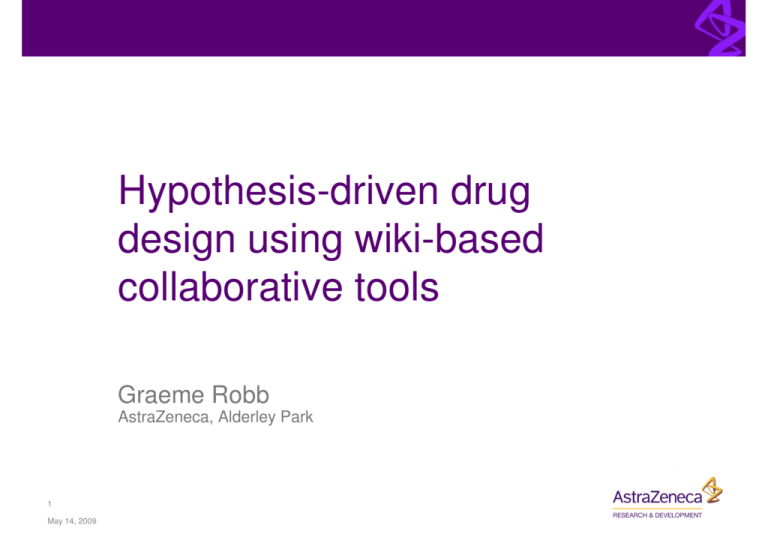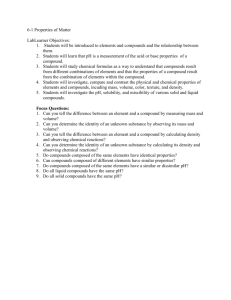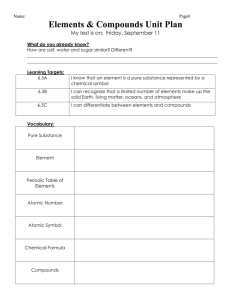Hypothesis-driven drug design using wiki
advertisement

Hypothesis-driven drug design using wiki-based collaborative tools Graeme Robb AstraZeneca, Alderley Park 1 May 14, 2009 Overview • Philosophy Discussion • Hypothesis-Driven Design • A Solution from the Zeitgeist • Chemistry (finally) • Real Data; Real Value 2 May 14, 2009 Drug Design Philosophy 101 The Quantity Argument... • Focus on: making larger numbers of compounds • In a nutshell: ‘there are more needles in a larger haystack’ • Constrained by: only using easy chemistry / available reagents • Opportunity: rapid SAR exploration • Risk: never explore ‘hard’ chemistry; never find best compounds • The Quality Argument... • Focus on: making the right compounds • In a nutshell: ‘using all our expertise we can do much better than chance’ • Constrained by: our imaginations! • Opportunity: waste less on non-productive avenues • Risk: bespoke synthesis means fewer compounds 3 May 14, 2009 The Circle of Progress Design Make Analyse Test 4 May 14, 2009 The Circle of Progress Quantity Design Make Creative thinking and innovation are underused Analyse Test 4 May 14, 2009 Puts bottleneck at ‘Make’, and ‘Test’ must keep up. Very resource intensive The Circle of Progress Quality Puts emphasis on design, to pick the right compounds. Quantity Design Make Analysis is key component of good design. Make and Test still at capacity, but less resource intensive as fewer compounds. No bottleneck! 5 May 14, 2009 Puts bottleneck at ‘Make’, and ‘Test’ must keep up. Very resource intensive Creative thinking and innovation are underused Analyse Test Focus on Quality • The best method (opinion!) • Certainly best for Lead Optimisation (LO) • May not always be appropriate for Lead Generation (LG) • Makes best use of limited make and test resources • Have to ensure you make the right compounds • Take the shortest route from lead to CD (candidate drug) • Be systematic, and transparent about rationale • Only make key compounds to address issues and add maximum value Hypothesis Driven Drug Design 6 May 14, 2009 Be Hypothesis-Driven • Compound design is focused on addressing specific issues • Ensures chemistry is aligned with project issues • Formulate a hypothesis of a potential solution • Design compounds to test this hypothesis • Analyse results to assess hypothesis add to collective knowledge • Lean Design • Make minimum number of compounds necessary to answer the question • Do not make compounds with predicted poor outcomes • Do not make a compound without a purpose • Exponential success: • The more we do, the more we understand, the better we design. 7 May 14, 2009 Be Hypothesis-Driven Process for ensuring the right compounds are made Issues are defined by the project Issue ? Sharing Hypothesis Design Idea Set of Compounds Review Prioritisation Make & Test Outcome/ Learning Decisions Analysis informs the next hypothesis A suggestion of how to tackle an issue 8 May 14, 2009 An idea of compounds to answer a hypothesis Specific compounds best fitting the idea Compound Progression Designer • Focus on designer role as key • “Quality of a compound is fixed at the moment of conception” • Need experts with time dedicated to design • Need multi-disciplines (esp. in LO) to see whole picture • Need to collaborate effectively • Traditional methods are often entrenched • Move from individual to collective... • Move from ‘what can we make’ to ‘what should we make’... • We need a paradigm shift..... • We need... 9 May 14, 2009 In 1972, a crack chemistry team began making drugs. These men promptly decided on the best methods and stuck to them. Today, still using these outdated methods, they miss opportunities for innovative drug design. If you have this problem, if no one else can help, and if you can make them, maybe you should form... 10 May 14, 2009 Design Teams • Now adopted across much of AstraZeneca • Especially in LO • Multidisciplinary team of experts • Meet for regular, short meetings • Time allocated to design and analysis • New way of working – need new tools • Need to communicate within design teams • Need to efficiently share / collaborate • Need to make decisions • Need to have transparency 11 May 14, 2009 An Old Solution • There is nothing new under the sun • Some have tried this before... • But often fails, or effectively ends up with a team of one • Problem is the tools • Shared spreadsheets and documents on a server or in email • People lose the links, don’t read the email or can’t be bothered to update • Multiple copies of data can get out of synchronisation • Files are not always accessible by everyone (esp. in meetings) • Data often hard to find, being ‘hidden’ inside files. • Not integrated into workflows • Requires extra effort People just don’t have time 12 May 14, 2009 A New Solution • Take inspiration from the zeitgeist! • Current growth in IT tools is on the internet • Social networking, online encyclopaedias, blogs, wikis, etc. • “Web 2.0” • Facilitate communication and collaboration • Constantly updating • Interoperative – bringing data in from multiple source • Remix content (‘mashup’) for different purposes and tasks • Increased benefits from ever greater numbers of users • All online – no client software; works from any PC 13 May 14, 2009 A CoDD • Compound Design Database • Based on Wiki / MySQL technologies • Why use Wiki? • Web-based, so no client software to develop • Easy to prototype • Fast and easy to use • Easy to customise for our requirements • Can handle multiple simultaneous edits • Always up-to-date • Has all the history/version features needed • Can plug in oechem for added functionality • It’s free (mediawiki) 14 May 14, 2009 A CoDD • Each project uses a page in the wiki to record, discuss and comment upon design ideas • Common platform for all users • Single one-stop-shop gives access to all relevant data main portal 15 May 14, 2009 A CoDD • Each project uses a page in the wiki to record, discuss and comment upon design ideas • Common platform for all users • Single one-stop-shop gives access to all relevant data Designset template 16 May 14, 2009 A CoDD • Each project uses a page in the wiki to record, discuss and comment upon design ideas • Common platform for all users • Single one-stop-shop gives access to all relevant data Classification hierarchy Designset template 16 May 14, 2009 A CoDD • Each project uses a page in the wiki to record, discuss and comment upon design ideas • Common platform for all users • Single one-stop-shop gives access to all relevant data Classification hierarchy Representative structure Designset template 16 May 14, 2009 A CoDD • Each project uses a page in the wiki to record, discuss and comment upon design ideas • Common platform for all users • Single one-stop-shop gives access to all relevant data Classification hierarchy Representative structure Compound upload viewing links 16 May 14, 2009 Designset template A CoDD • Each project uses a page in the wiki to record, discuss and comment upon design ideas • Common platform for all users • Single one-stop-shop gives access to all relevant data Classification hierarchy Data to help track progress, decisions, responsibility Representative structure Compound upload viewing links 16 May 14, 2009 Designset template A CoDD • Each project uses a page in the wiki to record, discuss and comment upon design ideas • Common platform for all users • Single one-stop-shop gives access to all relevant data Classification hierarchy Representative structure Compound upload viewing links 16 May 14, 2009 Data to help track progress, decisions, responsibility Explanation, discussion, comments Designset template A CoDD • Each project uses a page in the wiki to record, discuss and comment upon design ideas • Common platform for all users • Single one-stop-shop gives access to all relevant data Classification hierarchy Representative structure Data to help track progress, decisions, responsibility Explanation, discussion, comments Link out to other data Compound upload viewing links 16 May 14, 2009 Designset template A CoDD • But more than just a wiki.... • Wiki is good for managing the editing • Less good for visualisation, data- or structure-searching • So extract and reformat data from wiki mysql tables • Merge with in-house data on real compounds • Display anyway you like 17 May 14, 2009 A CoDD • But more than just a wiki.... • Wiki is good for managing the editing • Less good for visualisation, data- or structure-searching • So extract and reformat data from wiki mysql tables • Merge with in-house data on real compounds • Display anyway you like 17 May 14, 2009 A CoDD • But more than just a wiki.... • Wiki is good for managing the editing • Less good for visualisation, data- or structure-searching • So extract and reformat data from wiki mysql tables • Merge with in-house data on real compounds • Display anyway you like 17 May 14, 2009 A CoDD • But more than just a wiki.... • Wiki is good for managing the editing • Less good for visualisation, data- or structure-searching • So extract and reformat data from wiki mysql tables • Merge with in-house data on real compounds • Display anyway you like 17 May 14, 2009 A CoDD • Crucially, the system does not ‘do’ design for you • Only keeps track and organises • Make things easier to find / share • Saves time • Frees up more time for being creative • Do better design • Do more thorough analysis • Linked in to all parts of the D-M-T-A cycle • Track all designs for easy decision making • Assign synthesis and testing for compounds from the tool • Alerting when data is ready for analysis 18 May 14, 2009 Visual Planning • Progress chart view for visual planning Colour scheme indicates different areas of chemistry here. 142: Amide isosteres (1/6) 19 May 14, 2009 *Real data! (except structure) so I have obscured the detail. Added Chemistry • A powerful computational chemistry platform • Not just an organisational tool • Contains a database of all past, present and future compounds • Huge scope for predictive modelling • Can highlight ‘good’ compounds for rapid advancement • Can caution against ‘bad’ compounds for possible problems • Perform well in advance of decision to sanction synthesis • Using ‘Web2.0’ principles • Capture more data inform models better prediction 20 May 14, 2009 Property Prediction • QSAR modelling using descriptor based PLS • Some drawbacks • Imperfect descriptors give only locally correct models Phys>LogD>pH7.4 • Nothing new about that 4 3 2 1 • Errors increase for compounds dissimilar to the training set 1 2 3 Pred Formula Phys>LogD>pH7.4 • But here designs are generally following up on previous compounds • All previous compounds in the training set • Local model is appropriate (especially in LO) • Accurate predicted properties for compounds returned shortly after being entered in the tool. • Lipophilicity, Solubility, Plasma Protein Binding, etc • Use these to inform progression decisions 21 May 14, 2009 4 Auto-Docking and Visualisation • Same principle applies to docking • Expert-created restricted docking script • Ensures you get the ‘right’ answer or none • Many docking programs output multiple scores per pose • Fit the pIC50 using docking scores as descriptors • Can give reasonable potency prediction for new compounds • Same caveats about being close to training set apply 22 May 14, 2009 Toxophore Alerting • We have a wealth of experience identifying and solving problems caused by toxic substructures (‘toxophores’) • But transfer of this knowledge is often poor and limited to postrationalisation after (expensive) in-vivo findings. • Here we have begun encoding knowledge as precise toxophores with accompanying explanation and potential solutions • Every compound you could potentially make is screened and alerts emailed to design teams with explanation of the problem. S HN N H NH • CoDD link: Pyridine Variations H2N O 23 May 14, 2009 N This is a compound from designset 201 and has been identified as containing a toxophore relating to genotoxicity*. Possibly not every compound containing this substructure is toxic, but you may want to investigate further. • Click for a summary of why this is a toxophore. * fictitious example New Compound Suggestions • Can accurately model compound properties using a FreeWilson approach • Each group/fragment in a molecule contributes to a property • Whole molecule property is a sum of the group contributions • Makes assumption about additivity – need to test S N H N NH H2N * HN HN S N H * + * * NH H2N + + * * O N O • Generate all possible fragment combinations • Predict properties from Free-Wilson models • Automatically generate the top, unmade compounds 24 • Useful compliment to the creative design process May 14, 2009 Real Value • Mean Time spent on each DesignSet (set of compounds) for 5 projects in LO Before 200 After Test & Analyse Make Design 200 24 63.9 150 Test & Analyse Make Design3 Design2 Design1 150 24 New Design Culture 24 100 31.2 100 53.8 24 49 73 25.3 30.4 117 25.4 45.6 50 50 61.3 35.6 58.4 13.1 46.3 31.2 6.9 6.8 8.3 13 7.9 Proj3 Proj5 5.1 4.6 0 0 25 36.4 Proj1 May 14, 2009 Proj2 Proj3 Proj4 || Project was temporarily under resourced Proj1 Proj2 || Project had stopped design activity Summary • Greater need superior design quality • Form a design team of experts • Wikis and Facebook inspire the idea of ‘Social Design’ tools • Integrate with all systems • Use very visual display to make understanding easier • Frees up time for more creativity • Powerful computational platform • Add value to ideas generated by any designer • Make more-informed decisions 26 May 14, 2009 All compound structures taken from: Cocco, Maria T.; Congiu, Cenzo; Onnis, Valentina. Synthesis and in vitro antitumoral activity of new N-phenyl-3-pyrrolecarbothioamides. Bioorganic & Medicinal Chemistry (2003), 11(4), 495-503.





